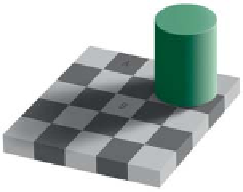Graphics Reference
In-Depth Information
As computer displays have become commonplace and dialog boxes for choosing
colors with RGB sliders have proliferated, one sometimes hears that color is just
a mix of red, green, and blue. As we've seen already, there are many colors that
cannot be made either by mixing red, green, and blue dyes/inks/paints or by mix-
ing red, green, and blue lights. It
is
true that such mixes can generate a great many
colors, but not all.
and Weaknesses
The physiological description of sensor responses to light is still a step away from
the perception of color; that happens in the brain. When those perceptions
do
occur, we confidently say that we saw something red, or blue, or yellow. But
numerous optical illusions show that we may be overconfident. We can summarize
a few key things. We're good at
• Detecting differences between adjacent colors
• Maintaining our sense of the “color of an object” in the presence of chang-
ing illumination (see Figure 28.15)
We're not very good at telling whether two widely separated colors are the
same, or remembering a color from one day to the next. Then again, given the
changing lighting circumstances we constantly encounter, this is probably an
advantage rather than a limitation.
With the goal of having a common language for describing color, there's been a
great deal of work in providing standards. The Pantone™ color-matching system
is a naming system in which a wide variety of color chips are given standard
numbers so that a printer can say, for instance, “I need Pantone 170C here.” The
numbers refer to calibrated mixes of certain standardized inks.
Figure 28.15: The squares labeled A and B have identical gray values, but we perceive
them as very different shades of gray; indeed, we're inclined to call one a “white square”
and the other a “black square.” One may regard this as a failure of the visual system to
“recognize the same color,” but it's more appropriate to regard it as the success of the visual
system in detecting color constancy in the presence of varying illumination: We perceive
all the black squares to be black even though the actual gray values in the image vary
substantially. (Courtesy of Edward H. Adelson.)



